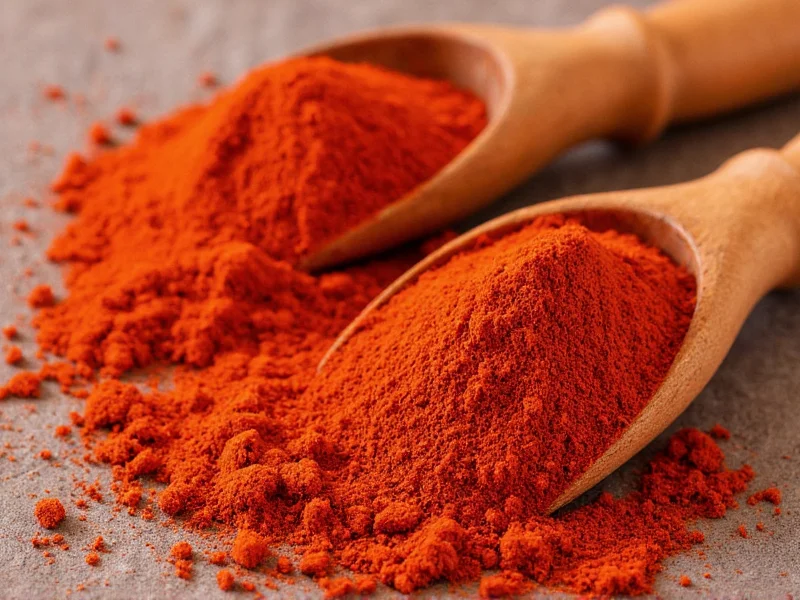Understanding Paprika: More Than Just a Red Powder
Paprika is a ground spice made from dried sweet or hot peppers belonging to the Capsicum annuum species. Originating in Central America, it traveled to Europe through trade routes and became particularly prominent in Hungarian and Spanish cuisines. The confusion between “paprika” and “sweet paprika” stems from inconsistent labeling practices and regional naming conventions.
The Paprika Spectrum: Types and Terminology
What many don't realize is that “paprika” serves as an umbrella term for several distinct varieties. The key differentiators are heat level and processing method. When a package simply says “paprika” in American grocery stores, it typically refers to the sweet variety, creating unnecessary confusion for home cooks.
| Type of Paprika | Heat Level (Scoville) | Primary Flavor Notes | Common Regional Names |
|---|---|---|---|
| Sweet Paprika | 0-100 SHU | Earthy, slightly sweet, fruity | Hungarian noble sweet, Spanish dulce |
| Hot Paprika | 500-1,000 SHU | Peppery heat with underlying sweetness | Hungarian erős, Spanish picante |
| Smoked Paprika | Varies (sweet or hot) | Deep smokiness, wood-fired notes | Spanish pimentón de la Vera |
Why the Naming Confusion Exists
In Hungary, paprika's spiritual home, the spice is classified by quality and heat level rather than having separate names. The term “sweet paprika” emerged primarily in English-speaking markets to distinguish the mild variety from spicy alternatives. When shopping outside specialty stores, “regular paprika” almost always means sweet paprika—the default version used in dishes like Hungarian goulash and deviled eggs.
Flavor Profiles and Culinary Applications
Sweet paprika delivers vibrant color and subtle pepper flavor without heat, making it ideal for dishes where you want visual appeal without spiciness. It shines in potato salads, roasted vegetables, and as a finishing touch on soups. Hot paprika, containing some spicy pepper varieties in the blend, adds noticeable heat while maintaining that characteristic paprika earthiness—perfect for chili con carne or spicy sausage preparations.
Smoked paprika, whether sweet or hot, undergoes a smoking process that imparts a distinctive campfire-like flavor. This variety works exceptionally well in bean dishes, barbecue rubs, and Spanish recipes like paella. Understanding these differences between sweet paprika and other paprika varieties prevents recipe disasters and elevates your cooking.
Substitution Guidance for Home Cooks
When a recipe calls specifically for sweet paprika, substituting hot paprika will significantly alter the dish's heat profile. For authentic Hungarian dishes, this substitution could ruin the intended flavor balance. If you only have hot paprika but need sweet, use about half the amount and consider adding a pinch of sugar to compensate for the missing sweetness.
Smoked paprika makes a poor substitute for sweet paprika in most applications due to its dominant smoky flavor, which would overwhelm dishes like potato salad or chicken paprikash. The reverse is equally problematic—using sweet paprika where smoked is called for will miss the essential smoky dimension in recipes like chorizo or certain bean stews.
Shopping and Storage Best Practices
For the most vibrant color and flavor, seek paprika labeled with specific regional designations like “Hungarian noble sweet” or “Spanish pimentón dulce.” These indicate careful production methods and quality control. Avoid generic “paprika” without further specification, as it may be a blend that doesn't deliver consistent results.
Store paprika in an airtight container away from light and heat. Properly stored, it maintains peak flavor for 6-12 months, though it remains safe indefinitely. Check freshness by rubbing a small amount between your fingers—fresh paprika should leave a vibrant red stain and emit a distinctly sweet, peppery aroma. Stale paprika loses both color intensity and flavor complexity, resulting in dull-tasting dishes.
Global Paprika Traditions
Hungarian paprika production follows strict quality standards with eight official classifications based on color, pungency, and flavor. Spanish paprika (pimentón) often undergoes smoking over oak fires, creating distinctive regional varieties. American paprika typically follows the Hungarian sweet style but lacks the depth of flavor found in traditionally produced European varieties.
When exploring authentic recipes, pay attention to regional specifications. Hungarian chicken paprikash requires sweet paprika for authenticity, while Spanish patatas bravas traditionally uses smoked paprika. Understanding these regional differences between paprika varieties enhances both your cooking accuracy and cultural appreciation.
Frequently Asked Questions
Is sweet paprika the same as regular paprika?
In most grocery stores, “regular paprika” refers to sweet paprika. The term “paprika” alone is often used interchangeably with sweet paprika in everyday cooking contexts, though technically paprika includes hot and smoked varieties as well.
Can I substitute sweet paprika for hot paprika?
You can substitute sweet paprika for hot paprika only if you don't want heat in your dish. To approximate hot paprika's flavor profile, combine sweet paprika with a pinch of cayenne pepper. The reverse substitution (using hot when sweet is called for) will make your dish spicier than intended.
Why does my paprika taste bitter?
Bitter paprika usually indicates it's old or was exposed to high heat. Paprika burns easily when added directly to hot oil—always add it toward the end of cooking or bloom it in cool oil first. Old paprika loses its sweet notes and develops bitterness as the volatile compounds degrade.
What's the difference between Hungarian and Spanish paprika?
Hungarian paprika focuses on sweet varieties with eight quality grades, while Spanish paprika (pimentón) is often smoked over oak fires. Hungarian styles range from sweet to hot, while Spanish varieties come in sweet (dulce), bittersweet (agridulce), and hot (picante) smoked options.
How can I tell if my paprika is still good?
Fresh paprika should have a vibrant red color and leave a strong stain on your fingers. It should smell sweetly peppery, not musty or dull. If it doesn't noticeably color your skin when rubbed between fingers or lacks aroma, it's lost potency and should be replaced for best results in your cooking.











 浙公网安备
33010002000092号
浙公网安备
33010002000092号 浙B2-20120091-4
浙B2-20120091-4